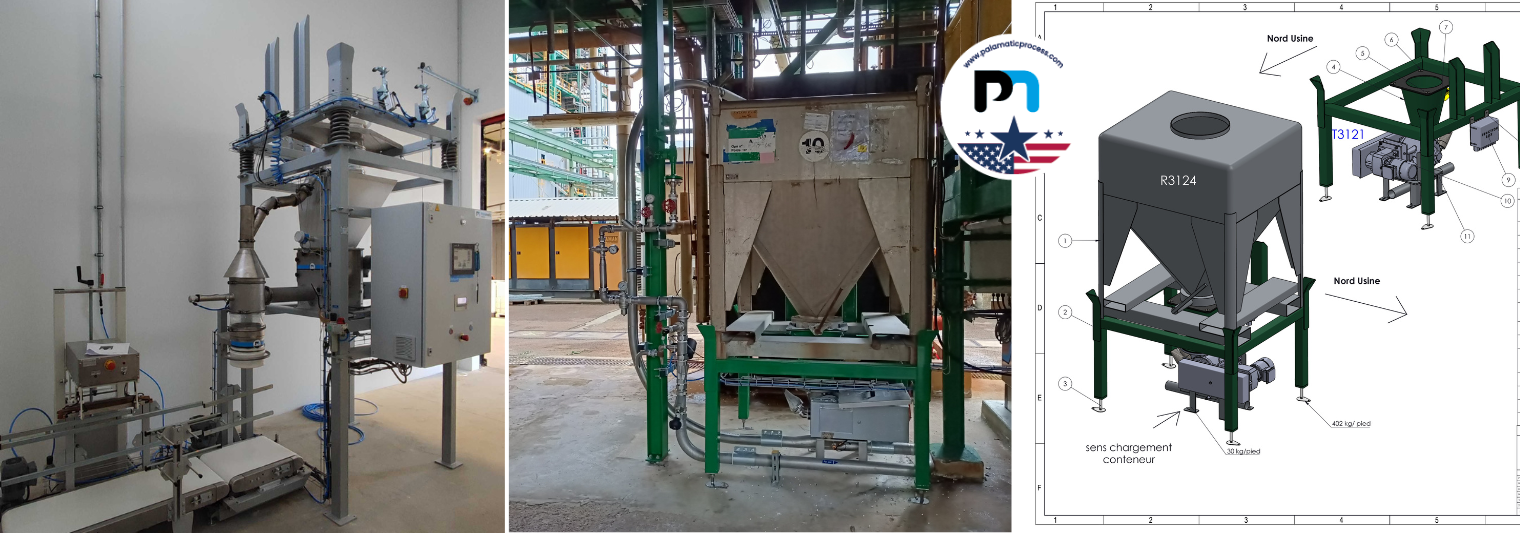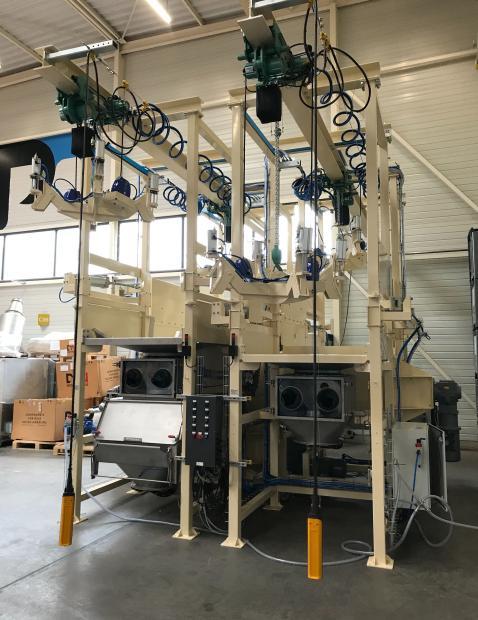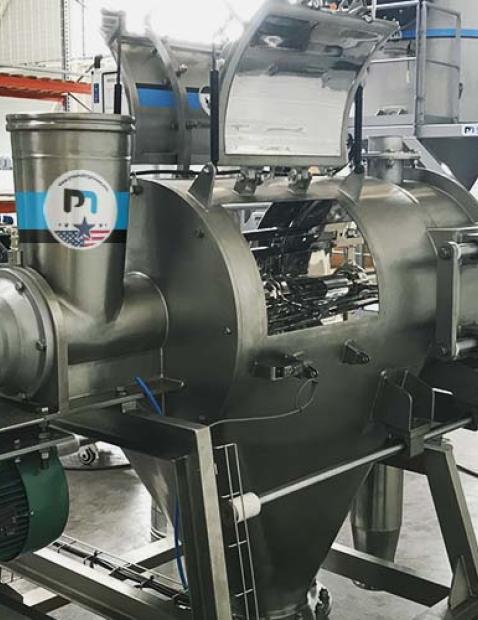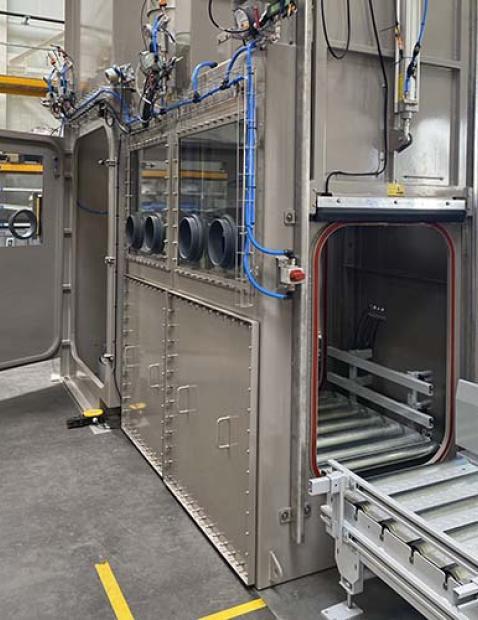IBC container discharge: why are IBCs the preferred choice for powders and bulk materials?

In industries that process powders and granular bulk materials, selecting the right container is key to ensuring efficient material transfer, minimizing product loss, and protecting operators. Whether using bulk bags, drums, sacks, octabins, or IBCs—each storage solution comes with its pros and cons depending on hygiene, containment, and ergonomics.
IBC containers (Intermediate Bulk Containers) have gained popularity across U.S. industries for their ability to optimize product flow, control dust emissions, and adapt to a range of processes. Why are more manufacturers shifting to IBCs? What advantages do they offer in terms of clean handling, traceability, and worker safety? This article explores best practices for filling and discharging IBCs, and the equipment that makes sealed powder transfer possible.
1. Comparing storage and discharge solutions for bulk powders
Each bulk storage and discharge method presents advantages and limitations depending on the type of material, flow characteristics, and production scale. Below is a breakdown of common solutions used in U.S. manufacturing for managing powders and granulates efficiently.
1.1. Bulk bags: a budget-friendly but limiting choice
Bulk bags are widely used due to their low cost and flexible storage capacity. However, they pose flow issues such as bridging and clumping, which can disrupt operations. Opening bulk bags also typically releases significant dust, impacting cleanliness and safety. Additionally, they require lifting equipment such as hoists or forklifts, which adds to the complexity of material handling.
1.2. Drums and sacks: best for small quantities
Drums and sacks are suitable for low-volume applications, often used in labs or specialty production. While easy to transport and handle, they require frequent manual intervention and pose higher contamination risks due to repetitive opening. Managing packaging waste is also less efficient than using large-capacity containers.
1.3. Octabins: balancing volume and protection
Octabins are more robust than bulk bags and offer improved dust control and product protection. Their rigid walls make them ideal for shipping large quantities. However, they often need specialized equipment to ensure clean and efficient discharge. For more info on safe discharge setups, see Palamatic Process IBC discharge solutions.
1.4. IBCs: optimized for contained and controlled discharge
IBC containers strike the perfect balance between efficiency, cleanliness, and reusability. Their rigid design prevents clogging during discharge, and they offer partial emptying capabilities for more precise batching. Sealed discharge systems significantly reduce dust and exposure, protecting both product integrity and operators. IBCs are also compatible with automated washing systems, ensuring high standards for hygiene and cross-contamination prevention.
2. Key reasons to use IBCs for powder and bulk material discharge
2.1. Cleaner and safer discharge
Discharging powders and bulk solids presents challenges like dust emissions, material loss, and operator exposure. IBC containers offer sealed, controlled flow and can be equipped with containment systems to minimize airborne dust. This ensures a cleaner production environment and improves workplace safety.
2.2. Greater flexibility with raw materials
IBC containers allow for partial discharge, which means operators can draw only the amount of product needed without emptying the full container. This adds flexibility to the process, improves stock management, and reduces product waste. Their sealed design also limits cross-contamination when switching products.
2.3. Operator-friendly design and ergonomics
Modern IBC systems are designed with operator ergonomics in mind. Their height and outlet positioning make them easier to access than bulk bags or octabins. IBCs are also compatible with dosing systems, allowing for automation and reduced manual handling, which leads to fewer errors and lower strain on workers.

Planning a bulk powder discharge project with IBCs ?
I’m here to guide you and offer expert support through your system evaluation.
Guillaume, expert in IBC powder discharge systems
3. How to fill an IBC container ?
3.1. Gravity filling
Gravity filling is the most basic and cost-effective method. The IBC is placed below a silo or hopper outlet, and the product flows downward when the valve is opened. This works well for free-flowing powders, but may cause dust release if not paired with a proper sealing system.
3.2. Manual sealed system
For better dust control and hygiene, a manual sealed system is used. A movable cover plate or inflatable seal keeps the filling point enclosed during operation. While this setup requires some operator interaction, it effectively prevents external contamination. Learn more about dust containment systems for IBC filling.
3.3. Fully sealed filling system
When dealing with hazardous, volatile, or sensitive powders, a fully sealed filling solution is the best option. This uses an inflatable seal to completely enclose the IBC inlet and prevent dust leaks. Air pressure control can be integrated to balance internal volume, making this ideal for pharmaceutical, chemical, or food applications.
4. How to discharge an IBC container ?
4.1. Gravity discharge
In most setups, the IBC container is positioned above a receiving hopper or feeder, and the outlet valve is opened to allow the product to flow by gravity. This is a simple method but can result in dust emissions unless proper containment systems are in place.
4.2. Tulip seal connection
A tulip seal provides a dust-tight connection between the IBC and the discharge station. The container is lowered onto a tulip-shaped seal that surrounds the outlet and prevents any product from escaping into the air. This is a preferred method in many advanced bulk handling systems.
4.3. Flow-assist discharge system
For materials that tend to bridge or clump, an IBC can be installed on a vibrating or massaging discharge station. These systems agitate the container gently, promoting consistent flow and preventing blockages. They are ideal for fine, sticky, or dense powders.
4.4. Split butterfly valve solution
To maintain hygiene and containment, a split butterfly valve can be used. One half is mounted to the IBC, and the other to the discharge station. When connected, they form a sealed transfer point that ensures zero product loss and zero contamination. This is ideal for pharmaceutical, chemical, or high-purity applications.
5. FAQ – Frequently Asked Questions
5.1. Are IBCs more expensive than bulk bags?
Yes, IBC containers have a higher initial cost compared to single-use bulk bags. However, they are reusable, more hygienic, and offer better containment and flow control, resulting in long-term savings and reduced material loss.
5.2. How do I ensure a dust-free discharge?
Using an IBC in combination with a sealed discharge system—such as a tulip seal or split butterfly valve—is the most effective way to ensure contained, dust-free transfer. Dust extraction systems and vibration modules can further improve performance. Learn more at Palamatic Process containment solutions.
5.3. Can the discharge be automated?
Absolutely. Fully automated IBC discharge systems are available with features like sensor-controlled valves, flow rate adjustment, and real-time process monitoring. These systems enhance operator safety and improve consistency across production batches.
5.4. What is the capacity of an IBC?
IBC containers typically range from 500 to 1,500 liters. Custom configurations are available based on process constraints, flow rate, and storage capacity. The ideal volume depends on your material type and production scale.
5.5. Can a single IBC be used for different products?
Yes—if the IBC is properly cleaned between uses. Industrial cleaning systems can eliminate residue and prevent cross-contamination. Smooth-surface IBCs are easier to clean and are recommended for handling multiple product types. See more at Palamatic's IBC solutions.
Conclusion
IBC containers offer manufacturers a reliable, hygienic, and cost-effective solution for managing powders and bulk materials. Their rigid design supports controlled discharge with minimal product loss, while sealed systems protect both product integrity and worker safety.
Palamatic Process offers a range of solutions adapted to your operational needs:
- IBCFlow® 01: a simple and robust discharge station for basic applications.
- IBCFlow® 02: an automated version with integrated flow control systems.
- Custom-engineered designs: tailored to meet your specific process requirements.
Get in touch with our team today for a personalized assessment and discover how our IBC systems can optimize your powder transfer process.



















